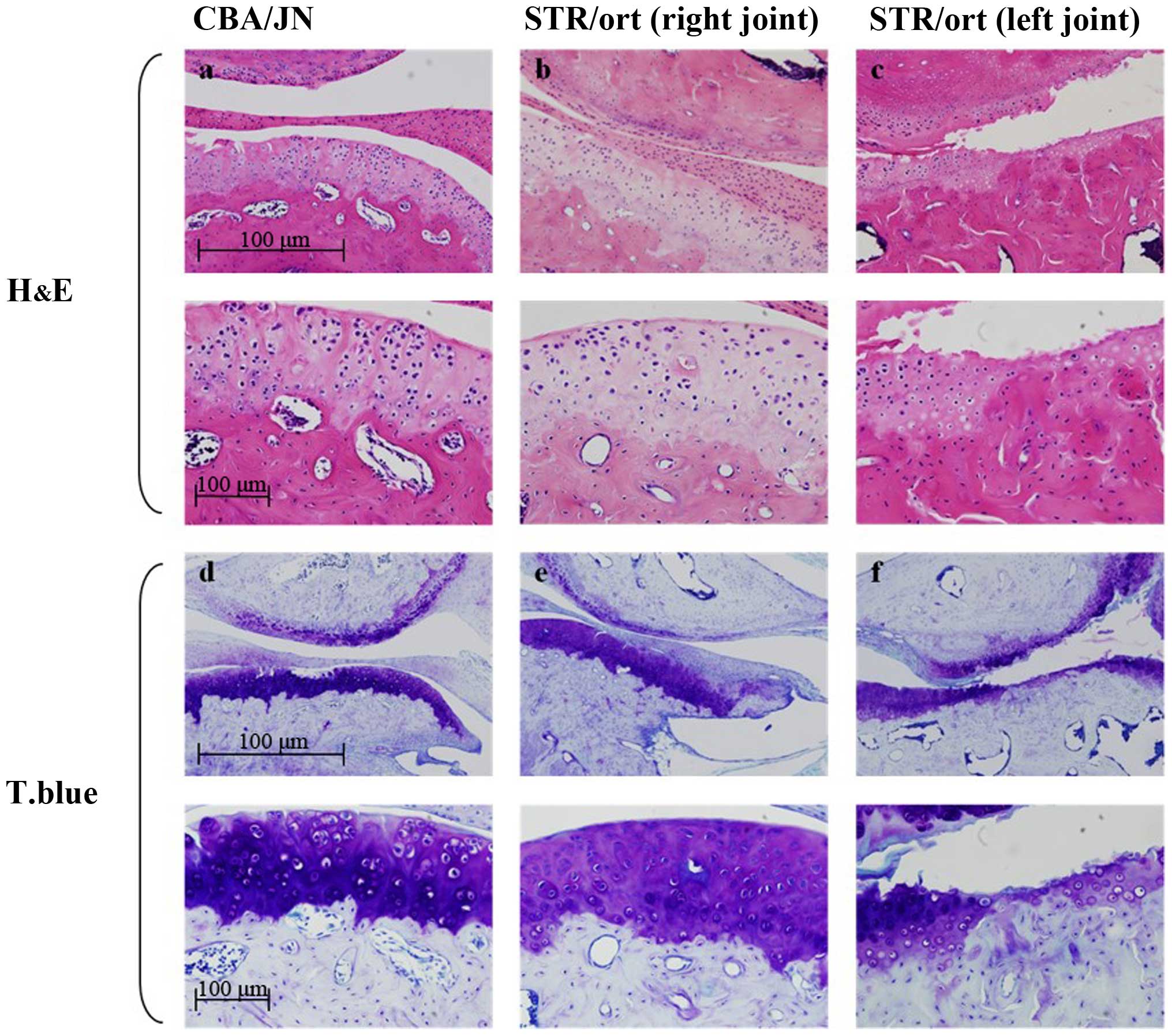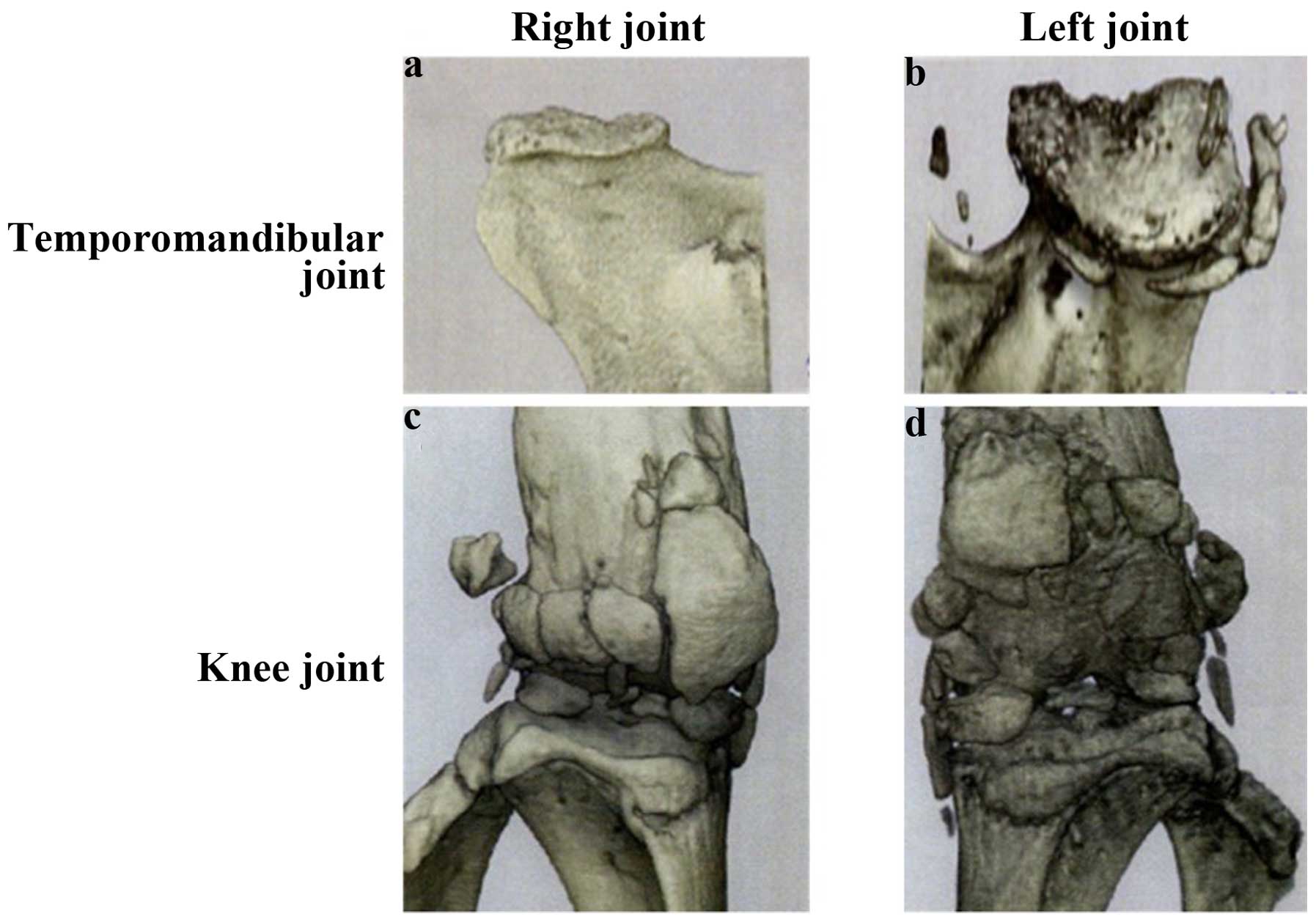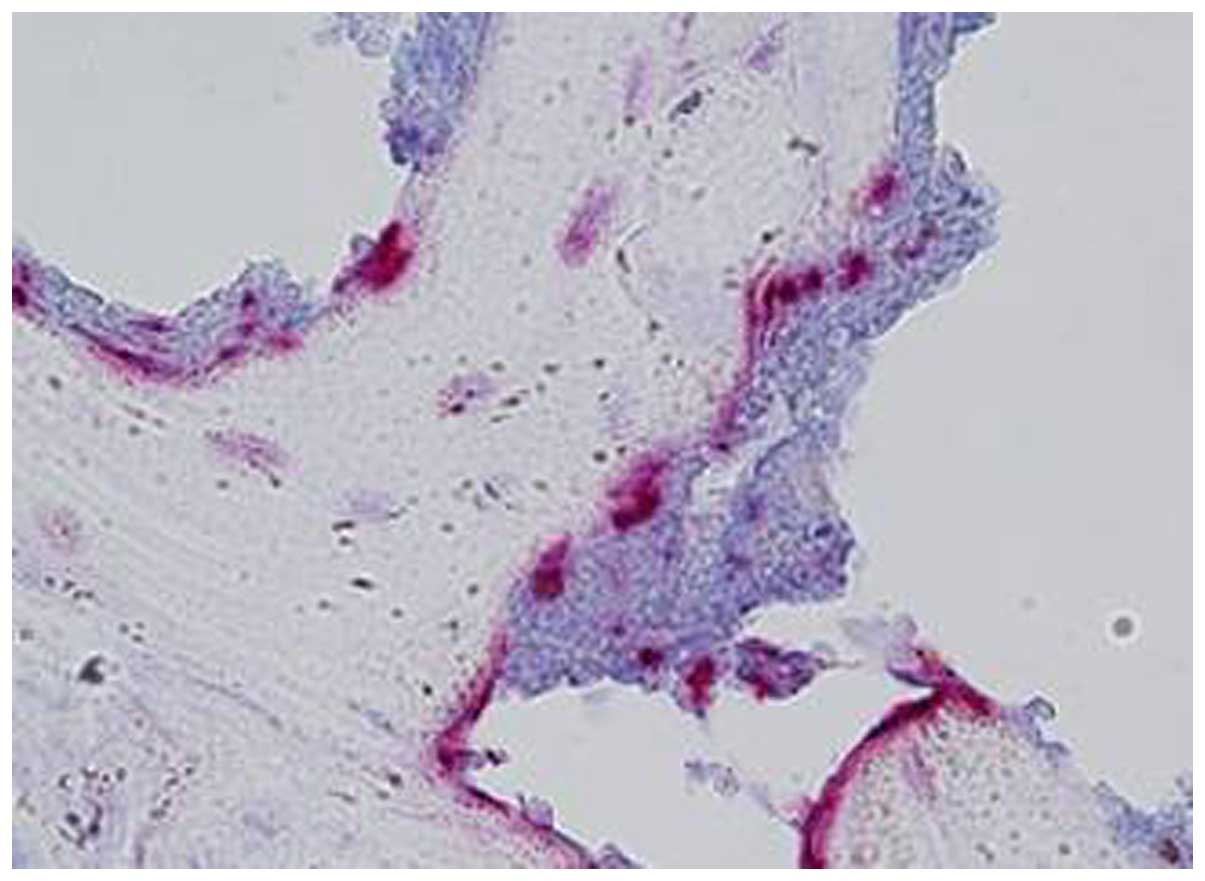Spontaneously developed osteoarthritis in the temporomandibular joint in STR/ort mice
- Authors:
- Published online on: May 21, 2015 https://doi.org/10.3892/br.2015.467
- Pages: 453-456
-
Copyright: © Kumagai et al. This is an open access article distributed under the terms of Creative Commons Attribution License.
Abstract
Introduction
The articular cartilage of the temporomandibular joint (TMJ) is composed of fibrocartilage, and undergoes endochondral ossification during the active growth period (1). TMJ osteoarthritis (OA) is typically a slowly progressive, asymmetric disease resulting in the destruction of articular tissues, and presents as functional pain, crepitus or multiple joint noises. Recent histological and biochemical studies of TMJ OA have provided evidence of breakdown of the fibrocartilage covering the articular surfaces of the mandibular condyle and temporal bone; however, the pathogenesis and natural progression of TMJ OA remain unclear. Several in vivo experimental animal models have been developed to study TMJ OA, including age-accelerated mice (2) and transgenic mice (3); however, there are no studies of TMJ OA in naturally occurring mice.
The STR/ort mouse often develops spontaneous OA of the medial tibial cartilage of the knee joint, and is a useful model for studying the pathogenesis of knee OA (4). The histopathological lesions of knee OA in STR/ort mice are progressive and closely resemble those of human knee OA. Eighty-five percent of STR/ort mice have histological OA lesions in the medial tibial cartilage by 35 weeks of age. However, there have been no studies regarding OA lesions in the TMJ of STR/ort mice to date.
To investigate the occurrence of OA and histological changes in the TMJ of STR/ort mice, the changes in the articular cartilage were examined using histological and microcomputed tomography (micro-CT) analyses.
Materials and methods
Mice
All the experimental procedures in the animal experiment were approved by the ethical committee for the guidelines on animal experiments of Tsurumi University, School of Dental Medicine (Yokohama, Kanagawa, Japan), Sagamihara National Hospital (Sagamihara, Kanagawa, Japan) and Nippon Dental University, School of Dentistry (Tokyo, Japan).
Thirty-two male STR/ort mice aged between 4 and 60 weeks were obtained from Charles River Laboratories, Inc. (Yokohama, Japan). The STR/ort mice were 30 (n=3), 40 (n=10), 50 (n=15) and 60 (n=4) weeks of age. Six age-matched male CBA/JN mice, which showed no evidence of histological OA lesions, were used as controls. The mice were housed ≤5/cage, with a 12:12-h light:dark cycle and with ad libitum access to standard mouse chow and water, ≤15 months of age. STR/ort mice were euthanized at 30, 40, 50, 60 or 70 weeks of age under diethyl ether anesthesia. The body weights of all the mice were recorded prior to euthanasia.
Histology
After euthanasia at 30 to 60 weeks of age, the STR/ort (n=32) and CBA/JN (n=6) mice were bisected at the level of the mandibular symphysis and stored in 70% ethanol. The mandible was fixed in 4% paraformaldehyde in 0.1 M phosphate-buffered saline (PBS) at pH 7.4 for 24 h at 4°C. Samples were rinsed with PBS, followed by decalcification in 10% EDTA for 8 weeks. Following dehydration with a graded ethanol series, the samples were passed through xylene and embedded in paraffin. The embedded condylar head samples were serially sectioned in frontal, sagittal and horizontal planes to produce 4-µm sections, which were deparaffinized. The serial sections were stained with hematoxylin and eosin (H&E), toluidine blue and tartrate-resistant acid phosphatase (TRAP) to observe the osteoid existence produced or newly produced by the osteoblasts.
Micro-CT
Three-dimensional morphometric analysis of the subchondral bone in the mandibular condylar heads was performed using two micro-CTs; R-mCT (Rigaku Co., Tokyo, Japan) and Latheta LCT-200 (Hitachi-Aloka, Tokyo, Japan). Three-dimensional reconstruction of the mandibular condyles was performed using a TRI-BON system (Ratoc System Engineering, Co., Ltd., Tokyo, Japan).
Results
Histological evaluation of mandibular condyles in CBA/JN and STR/ort mice
The control CBA mouse condyles were covered by fibrocartilage with distinct cellular layers: Fibrous, prechondroblastic and cartilaginous layers, and subchondral bone (Fig. 1a). By contrast, 17 of the 25 (68%) edematous 40- and 50-week-old STR/ort mice had unilateral changes in the mandibular condyles. There was an exposure of the differentiation and proliferation cartilage layer, the fibrocartilage layer was lost, and the contour of the subchondral bone was irregular (Fig. 1b). Furthermore, the articular cartilage layer was damaged, clear boundaries between cartilage layers were lost, and the arrangement of chondrocytes was more irregular compared to the control mice. There were no signs of inflammation or granular tissues in any tissue specimen from either the CBA/JN or the STR/ort mice (Fig. 1b).
Changes in the microarchitecture of subchondral TMJ bone with OA
Osteoarthritis-induced changes over time in the microarchitecture of the subchondral bone of the mandibular condyle were evaluated by micro-CT analysis. No significant differences were identified at 30 weeks between CBA and STR/ort mice in any of the micro-CT parameters examined. However, at 40 weeks, osteoarthritic morphological changes and structural alterations were observed in the STR/ort mice compared with the CBA controls (Fig. 2). The articular cartilage was thinner in STR/ort mice than that in the CBA mice. There were no significant differences in the fibrous or prechondroblastic layers between CBA and STR/ort mice.
Toluidine blue and TRAP staining of knee joints and mandibular condyles in STR/ort mice
The TMJ and knee joint sections obtained from 40- and 50-week-old STR/ort mice were stained with toluidine blue. In the STR/ort mice, there was less staining in the affected OA condyles due to the fewer chondrocyte numbers. Some metachromasia in the free bodies with toluidine blue staining in the superior joint space were also identified (Fig. 1). Additionally, multinucleated TRAP+ osteoclast-like cells were detected at the erosive front of the condyle, which is localized between the pannus and the bone surface (Fig. 3).
Discussion
The STR/ort mouse strain appears to develop spontaneous OA-like lesions in the TMJ. To the best of our knowledge, this is the first study of the histomorphometric characteristics of OA changes in the TMJ of STR/ort mice. At the age of 40 weeks, STR/ort mice often have loss of articular cartilage on histology, with cavitation and erosion of the exposed bone and gradual changes in condylar shape.
The initial joint pathology caused by OA is difficult to characterize in humans as OA is often diagnosed in the late stages of the disease. Animal models of OA can facilitate the understanding of the early pathology of OA, including loss of proteoglycans and fibrillations. Animal models of induced OA (5–8) of genetically modified mice (9,10) and of spontaneously occurring OA (11,12) have potential physiological relevance to the OA that develops spontaneously in humans.
STR/ort mice, an inbred sub-strain of STR/N mice, are a valuable animal model of spontaneous OA (13). Previous studies have suggested two possible etiologies for OA in the knee joints of male STR/ort mice: Biomechanically-induced OA (due to patellar luxation) and spontaneous OA caused by a lack of keratin sulfate, a change in proteoglycans. The spontaneous obesity of the strain suggests that excess body weight, or a factor associated with it, may play a role in the accelerated development of OA in this strain. However, the lack of correlation between OA and naturally varying or diet-altered body weight suggests that body weight alone is not a causal factor in the strain's spontaneous development of OA (13–15). The presence of degenerative changes in the TMJ of STR/ort mice suggests that the basis of the disease is systemic (16).
The TMJ is a diarthrodial joint similar to other load-bearing articular joints. Unlike the majority of diarthodial joints, in which the articular surfaces are covered by hyaline cartilage, those of the mandibular condyles are covered by fibrocartilage. Among the earliest molecular events involved in the pathogenesis of TMJ OA are the disruption of the collagenous components of the fibrocartilage and the subsequent loss of proteoglycans and glycosaminoglycans. The loss of these molecules eventually leads to articular tissues that lack resiliency to the compressive and shearing loads generated during jaw movements. As a result, the affected joint becomes increasingly susceptible to structural damage with repetitive mechanical loading. The cause of TMJ OA is thought to be the mechanical loading to the TMJ developed by parafunction. It has been reported that an imbalance between host factors and excessive mechanical stress to the TMJ may be associated with condylar resorption. Arnett et al (17) suggested that parafunctions may produce compression capable of initiating condylar resorption or enhancing resorption caused by other factors that have already initiated this process. However, certain cases often spontaneously develop TMJ OA without mechanical stress (18), therefore, there remain numerous unknown factors in association with the causes and progress of TMJ OA, and more information regarding its etiology and its natural course in untreated patients is desirable.
It has also been suggested that the cartilage of TMJ in normal mice is replaced by fibrocartilage, and is histologically established at 30 weeks of age (19). The articular cartilage of the condyle in STR/ort mice appears to develop spontaneous OA-like lesions that resemble human OA; therefore, the STR/ort mouse strain would be a useful model to study the pathogenesis of TMJ OA. Furthermore, as TMJ OA occurred concurrently with knee OA in STR/ort mice, the specific gene expression associated with cartilage degeneration may be involved in the pathogenesis of spontaneous TMJ OA. The development of TMJ OA may be associated with genetic factors in inbred laboratory mice. STR/ort mouse genetics are thought to affect vascular factors or synovial responses, enhancing the degeneration of the TMJ tissue. Further studies are required to clarify the mechanism of TMJ OA in STR/ort mice.
The underlying mechanisms of cartilage degeneration in TMJ OA have not been clearly identified. Determining the biomarkers for TMJ OA would lead to the elucidation of the initial changes in the disease. The identification of an experimental animal model that undergoes spontaneous TMJ OA degeneration is essential to help understand the disease pathogenesis. Thus, the STR/ort mice appear to be a promising research tool for an improved understanding of the pathogenic mechanisms involved in OA of the TMJ OA.
Acknowledgements
The authors would like to thank Dr Tsuyoshi Amemiya and Dr Hiroaki Shigematsu from Tsurumi University for their help in parts of the experiments. The authors also thank the Applied Medical Research Laboratory for the immunohistochemisty. The present study was supported by the JSPS KAKENHI (grant no. 25861985) for Young Scientists B, and (grant no. 23593004) from Scientific Research C.
References
|
Shen G and Darendeliler MA: The adaptive remodeling of condylar cartilage - a transition from chondrogenesis to osteogenesis. J Dent Res. 84:691–699. 2005. View Article : Google Scholar : PubMed/NCBI | |
|
Chen WH, Hosokawa M, Tsuboyama T, Ono T, Iizuka T and Takeda T: Age-related changes in the temporomandibular joint of the senescence accelerated mouse. SAM-P/3 as a new murine model of degenerative joint disease. Am J Pathol. 135:379–385. 1989.PubMed/NCBI | |
|
Embree M, Ono M, Kilts T, Walker D, Langguth J, Mao J, Bi Y, Barth JL and Young M: Role of subchondral bone during early-stage experimental TMJ osteoarthritis. J Dent Res. 90:1331–1338. 2011. View Article : Google Scholar : PubMed/NCBI | |
|
Chambers MG, Cox L, Chong L, Suri N, Cover P, Bayliss MT and Mason RM: Matrix metalloproteinases and aggrecanases cleave aggrecan in different zones of normal cartilage but colocalize in the development of osteoarthritic lesions in STR/ort mice. Arthritis Rheum. 44:1455–1465. 2001. View Article : Google Scholar : PubMed/NCBI | |
|
Mehraban F, Lark MW, Ahmed FN, Xu F and Moskowitz RW: Increased secretion and activity of matrix metalloproteinase-3 in synovial tissues and chondrocytes from experimental osteoarthritis. Osteoarthritis Cartilage. 6:286–294. 1998. View Article : Google Scholar : PubMed/NCBI | |
|
van de Loo FA, Joosten LA, van Lent PL, Arntz OJ and van den Berg WB: Role of interleukin-1, tumor necrosis factor alpha, and interleukin-6 in cartilage proteoglycan metabolism and destruction. Effect of in situ blocking in murine antigen- and zymosan-induced arthritis. Arthritis Rheum. 38:164–172. 1995. View Article : Google Scholar : PubMed/NCBI | |
|
Kammermann JR, Kincaid SA, Rumph PF, Baird DK and Visco DM: Tumor necrosis factor-alpha (TNF-alpha) in canine osteoarthritis: Immunolocalization of TNF-alpha, stromelysin and TNF receptors in canine osteoarthritic cartilage. Osteoarthritis Cartilage. 4:23–34. 1996. View Article : Google Scholar : PubMed/NCBI | |
|
Janusz MJ, Hookfin EB, Heitmeyer SA, Woessner JF, Freemont AJ, Hoyland JA, Brown KK, Hsieh LC, Almstead NG, De B, et al: Moderation of iodoacetate-induced experimental osteoarthritis in rats by matrix metalloproteinase inhibitors. Osteoarthritis Cartilage. 9:751–760. 2001. View Article : Google Scholar : PubMed/NCBI | |
|
Puzas JE, Landeau JM, Tallents R, Albright J, Schwarz EM and Landesberg R: Degradative pathways in tissues of the temporomandibular joint. Use of in vitro and in vivo models to characterize matrix metalloproteinase and cytokine activity. Cells Tissues Organs. 169:248–256. 2001. View Article : Google Scholar : PubMed/NCBI | |
|
Flannelly J, Chambers MG, Dudhia J, Hembry RM, Murphy G, Mason RM and Bayliss MT: Metalloproteinase and tissue inhibitor of metalloproteinase expression in the murine STR/ort model of osteoarthritis. Osteoarthritis Cartilage. 10:722–733. 2002. View Article : Google Scholar : PubMed/NCBI | |
|
Blumenfeld I, Laufer D and Livne E: Effects of transforming growth factor-beta 1 and interleukin-1 alpha on matrix synthesis in osteoarthritic cartilage of the temporo-mandibular joint in aged mice. Mech Ageing Dev. 95:101–111. 1997. View Article : Google Scholar : PubMed/NCBI | |
|
Huebner JL, Otterness IG, Freund EM, Caterson B and Kraus VB: Collagenase 1 and collagenase 3 expression in a guinea pig model of osteoarthritis. Arthritis Rheum. 41:877–890. 1998. View Article : Google Scholar : PubMed/NCBI | |
|
Mason RM, Chambers MG, Flannelly J, Gaffen JD, Dudhia J and Bayliss MT: The STR/ort mouse and its use as a model of osteoarthritis. Osteoarthritis Cartilage. 9:85–91. 2001. View Article : Google Scholar : PubMed/NCBI | |
|
Sokoloff L, Mickelsen O, Silverstein E, Jay GE Jr and Yamamoto RS: Experimental obesity and osteoarthritis. Am J Physiol. 198:765–770. 1960.PubMed/NCBI | |
|
Walton M: Obesity as an aetiological factor in the development of osteoarthrosis. Gerontology. 25:36–41. 1979. View Article : Google Scholar : PubMed/NCBI | |
|
Dreessen D and Halata Z: Age-related osteo-arthrotic degeneration of the temporomandibular joint in the mouse. Acta Anat (Basel). 139:91–96. 1990. View Article : Google Scholar : PubMed/NCBI | |
|
Arnett GW, Milam SB and Gottesman L: Progressive mandibular retrusion - idiopathic condylar resorption. Part I. Am J Orthod Dentofacial Orthop. 110:8–15. 1996. View Article : Google Scholar : PubMed/NCBI | |
|
Yamada K, Saito I, Hanada K and Hayashi T: Observation of three cases of temporomandibular joint osteoarthritis and mandibular morphology during adolescence using helical CT. J Oral Rehabil. 31:298–305. 2004. View Article : Google Scholar : PubMed/NCBI | |
|
Chen J, Sorensen KP, Gupta T, Kilts T, Young M and Wadhwa S: Altered functional loading causes differential effects in the subchondral bone and condylar cartilage in the temporomandibular joint from young mice. Osteoarthritis Cartilage. 17:354–361. 2009. View Article : Google Scholar : PubMed/NCBI |












